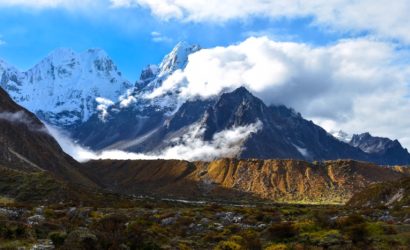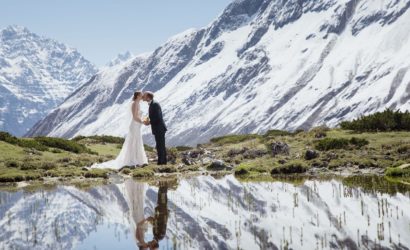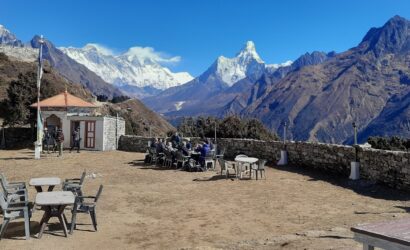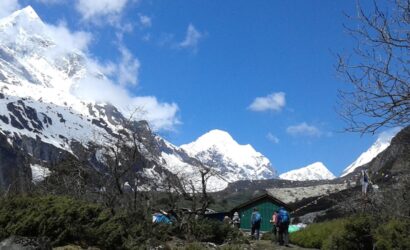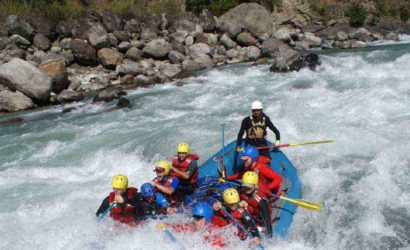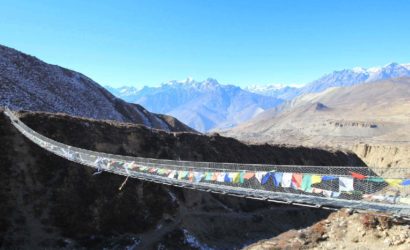Everest Base Camp via Gokyo Lakes and Chola Pass Trek, also known as Everest Circuit trek, is one of the most adventurous treks in the Everest Himalayas, it follows the route via high pass of Cho-La at 5330 meters into the Base Camp of Mount Everest. A unique trek that goes through Lukla, Namche bazaar and all the way to Gokyo, Chola Pass, Kalapattar and Everest Base Camp.
Leading you to the legendary Sherpa people‘s home, based at the foot of the world’s largest peak, Mt. Everest at 8848 meters. This trek follows the highly praised trekking route through the Dudh Koshi to its source the Gokyo Lakes to the west of the Everest Base Camp, giving you the benefit of a fantastic panoramic view of Cho Oyo, Everest and Makalu from the Gokyo Peak summit (5483 m).
As we cross the Chola pass and return back to Lukla following the route through Everest Base Camp, Kalapattar down to Tengboche monastery, Khumjung village, Namche Bazar and Lukla.
Enjoy the breathtaking views of Everest including several other similar peaks and discover the Buddhists monasteries located at the world’s highest elevation during EBC via Gokyo Lakes and Chola Pass Trek.
EBC via Gokyo Lakes & Chola Pass Trek Difficulty
The Everest Base Camp via Gokyo Lakes and Chola Pass Trek depends on the seasons that you are planning to do. It’s most difficult to do Everest Base Camp via Gokyo lakes and Chola pass trek during the winter. Crossing the Chola Pass is almost impossible due to heavy snowfall. In fact, due to various risk factors, the pass remains closed. During the night and early in the morning the temperature drops easily to a -15 to -20 degree celsius.
Spring is one of the best time to do this trek. The maximum temperature during sunny days is 25 degrees celsius during the spring. And in the morning and at night the minimum temperature is -10 to -15 degrees celsius.
This is a temperature suitable for trekking, which makes your treks much less difficult. During this time, in the lower altitude, you will see the view of clear blue skies and many different flower species. There are also many trekkers on the trials because of the peak season.
The monsoon season coincides with the summer from June to August. Therefore, due to rain at a lower altitude, it is not the best time to hike. Due to the slippery and muddy trails, the trail is difficult and risky.
Sometimes it rains even in regions above 4000 meters and even though it is sometimes dry. During this time, the maximum temperature averages 25 degrees celsius during sunny days, with morning and night a minimum of -10 to -15 degrees celsius.
Upon your arrival in the Kathmandu airport after completing your custom formalities Visa, etc. pick up your luggage and look for our airport representative from Himalaya Discovery, who will display your name on the board at the arrival gate.
You will be greeted by our representative and transferred to the hotel by private tourist vehicle.
Today is free for sightseeing in Kathmandu. You may wish to visit Durbar Square in the heart of the old city where the old Royal Palace, with its intricate woodcarving is located. The whole area is a maze of temples and images.
Leading away from the square in all directions are narrow alleys, full of the most amazing variety of shops and stalls. Some of these landmarks are considered World Heritage Sites including the historic Bhaktapur Durbar Square, the famous ‘Monkey Temple’ Swayambhunath and Buddhists shrine Buddhanath which is one of the largest Stupas in the world.
There will also be a full trip briefing today with gear check. In case you need to hire or buy equipment locally there will be time to do this today.
EBC, Gokyo and Chola pass trek begins with a scenic flight from Manthali airport to Lukla Tenzing Hillary airport (2,804 m).
Upon arrival at Lukla, you will meet our porters who will be carrying your bags. The Everest Base Camp hike starts after a short glimpse of the village of Lukla, where you will pass the village of Chaurikharka and then descend towards Dudh Koshi and Ghat.
From there, you follow the trails to Phakding via the bank of the Dudh Koshi river and stay overnight at Phakding.
Please note: Kathmandu to Lukla flight has been moved to Manthali airport, Ramechhap in peak trekking season Spring (March, April, May) and Autumn (September, October, November) due to increased traffic and since March 2019 renovations at Kathmandu airport.
Manthali airport can be reached by road from Kathmandu within 4 to 6 hours drive. This means you need to wake up early in the morning around 2:30 am to take a drive and catch your Lukla flight from Manthali early in the morning. Overnight at guesthouse. Overnight at guesthouse.
We continue trekking along the banks of the Dudh Kosi, crossing this majestic river many times on exciting suspension bridges laden with prayer flags. After entering Sagamartha National Park, the trail climbs steeply with breathtaking views.
Namche Bazaar known as the Gateway to Everest which is home to many quality restaurants, hotels, lodges, shops, Money exchange, internet cafe and a bakery. Namche is one of the biggest villages along the whole Everest trail. Overnight at guesthouse.
We will spend a day here in order to acclimatize and adjust to the thinning of the air. As well as a short trek where a museum is celebrating the traditional customs of the Sherpa people.
Today, we hike up the Syangboche Airport around Everest View Hotel. From this point, we can see rewarding views of the Himalayas with a stunning sunrise and sunset over the panorama of Khumbu peaks. Overnight at guesthouse.
Today, the trail climbs steeply out of valley through rhododendron forest, juniper and large conifers start to appear as the elevation increases making the trekking beautiful in spring.
The trail passes through Yak Kharkas and summer settlements. The views of Khumbi La and Tawache are magnificent throughout the day. Overnight at guesthouse.
The trail climbs a ridge for an excellent view both down the valley to Kengtega and up towards Cho Oyu and descend to a river and again climbs steep to the terminal moraine of the Ngozumpz glacier. We will reach at Machherma by early noon. Overnight at guesthouse.
Today the trek takes us at one of our final destination, Gokyo (4790meters). We will make this camp our base for 2-nights as we will have couple of sightseeing and hiking trips around Gokyo. Overnight at guesthouse.
Today, early in the morning we have steep climb up to the top of Gokyo Ri at elevation of 5483 meters, ample rewards to one attempts this trip.
There are stunning views of the supper Gokyo valley, the massive Ngozumpa Glacier and an incredible panoramic view of the whole Khumbu Himalayas, such as giants as Everest, Lhotse, Nuptse, Makalu, Cho-Oyu and Gychung Kang can be seen.
Those who explore the glacier and Gokyo peak are rewarded. This day we have for acclimatization and after noon back to the camp. Overnight at guesthouse.
Trekking to the foot of Cho La pass for our overnight stay at guesthouse.
Today is a long trek starting before sunrise at 4/5 am to reach the pass by 9-10 am otherwise weather conditions will greatly affect our journey. We cross over at an altitude of 5300 meters we could be exposed to strong winds if crossing too late.
We start to climb steeply that is regularly used and easy to follow. However, the problem may arise due to the altitude and snow. It often causes terrible problems to cross the pass if it is covered by snow. As you reach the top, you are rewarded by the magnificent views, then we descend to the Dzongla at noon. Overnight at guesthouse.
Today, we will take easy and short trekking route as we had big and hard trekking day yesterday. Overnight at guesthouse.
This is another big and difficult day walk along the Khumbu Glacier and up to Everest Base Camp at 5365meters. , the closest you can get to Mt. Everest without mountaineering equipment.
There will likely be a team there about to attempt the summit. The view of the Khumbu Icefall from Base Camp is spectacular. We return back to Gorak shep for the night. Overnight at guesthouse.
This will be one of the most difficult yet rewarding days of the trek. Most of morning in this day is spent climbing Mt. Kala Patar, a small peak (by Himalayan standards) at 5645 meters.
The ascent is demanding but the climber gets the most magnificent mountain panorama: Everest, the highest point on the planet at 29028ft, 8848meters, towers directly ahead and on all sides loom the other giants, Nuptse, Pumori, Chagatse, Lhotse and countless others.
We make a quick descent to Gorak Shep, a tiny hamlet at 5180 meters then trek down to Periche. Overnight at guesthouse.
From Periche we take a slightly different route down to Orsho then to Pangboche village. Here is the oldest monastery in the region which contains what is said to be the scalp and bones of a Yeti or abominable snowman-the.
Leaving mountains behind us our descent takes us through Tengboche Monastery at elevation of 3860 meters before continuing back to the town of Namche Bazaar at 3441meters. We arrive back into Namche Bazaar in the afternoon. Overnight at guesthouse.
Finally we return to Lukla where the trek began, which will seem like a lifetime ago. Enjoying time to reflect on the trek as a group and the personal achievement of all those who took part. Also giving you time to explore the town. Overnight at guesthouse.
Enjoying your last glimpse of the mountains you have recently visited for one last time.
On arrival in Kathmandu we are met and transferred back to hotel. You can rest and relax throughout the day.
It’s also spare day in case of bad weather in Lukla. If you get interested to take some gifts from Nepal for friends and relatives, visit to some nearby shops or go out in Thamel for typical Nepalese goods which can be assisted by our guide or you can do it yourself too.
In the evening we will have a farewell dinner in a traditional Nepalese restaurant with cultural performances.
The trip concludes! Our representative will drop you to the Kathmandu airport.


